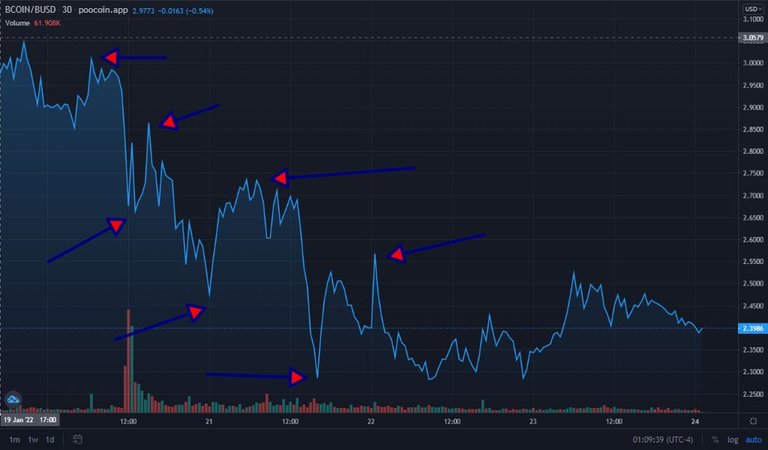Spanish

Saludos, ante todo quiero dejar muy claro que no soy experto en Trading ni pretendo serlo, escribo este artículo sobre mis experiencias de 1 año en el mundo de las criptomonedas. Si notas un error en el artículo siéntete libre de comentarlo, te lo voy a agradecer mucho, me gusta aprender y compartir lo que voy aprendiendo.
Si se trata de tu dinero recuerda siempre hacer DYOR (Siglas en inglés de Do your own research. "Haz tu propia investigación") y no invertir NUNCA lo que no estás dispuesto a perder.
Desde que entre en el mundo cripto ya venía con la idea fijada de que en este negocio se hacían ganancias comprando bajo y vendiendo alto, COMPRAR Y HOLDEAR, asi lo llaman, para todo principiante este el método recomendado. Este método puede tomar mucho tiempo, si compras un activo y este sufre una caída muy grande tendrás que mantenerlo hasta que vuelva a los precios de compra para recuperarte como mínimo.
En esta temporada bajista imagínate mi sorpresa al ver que hay gente ganando dinero también.
Son varios los métodos utilizados por los expertos para generar ganancias en medio de un mercado teñido de rojo, uno de ellos es el Scalping.
¿Qué es el Scalping?
Es básicamente vender un activo con la idea de recomprarlo cuando este en un precio más bajo; esperar que el precio vuelva a subir y volver a comenzar el ciclo. Aquí la ganancia que se genera no es mucha, pero al hacerlo repetidas veces, vas sumando, lógicamente al final de este proceso tendríamos más cantidad del activo sin invertir más capital para adquirirlo. Y si el activo entra en un marcado descenso puedes salir de él quedándote con más capital que cuando iniciaste la estrategia.
¿Pero suena igual a comprar y holdear o no? La diferencia acá es el tiempo. Un concepto tomado de la web lo define más claramente así: estrategia de trading que consiste en tratar de sacar ventaja de movimientos del precio relativamente pequeños y en espacios de tiempo cortos.
Para hacer Scalping al principio vas a necesitar herramientas que te ayuden a identificar un activo idóneo para trabajar con él.
Entre las muchas herramientas que se ponen en práctica hoy en día las que más utilizo por su sencillez son las siguientes, te las voy a mencionar y esta de tu parte investigar más sobre ellas si te interesa el scalping:
• El volumen de trading
• La acción del precio
• Los niveles de soporte y resistencia
• Patrones de gráficos de velas
Conociendo estas básicas herramientas ya te puedes aventurar a realizar tu primer scalping.
¿Qué otra cosa necesitas? TIEMPO, el scalping toma ganancia de periodos de volatilidad en los precios del activo por lo general muy cortos, pueden ser horas pero también minutos, entre una subida o bajada en los precios, por ello tienes que estar al tanto del gráfico constantemente.
Observen la siguiente gráfica. La misma esta configurada a 30 minutos, lo que nos muestra es el movimiento de un activo cada media hora, se aprecian las pequeñas pero constantes variaciones que se producen en ese intervalo de tiempo, son esas variaciones las que vamos a aprovechar:

Es obvio pero igual debo mencionar lo siguiente:
• Para hacer scalping debes operar en una red que te cobre poca de comisión, recuerda que vas a realizar varias transacciones en un periodo de tiempo corto, y los fees te afectan tu margen de ganancia. Redes como BSC y Solana son muy recomendables, Etherum descartada para principiantes!!
• Elegir una moneda estable para tu par preferiblemente que sea nativa de la red en que estas operando, suelen bajar mucho los fees por eso. Ejemplo BUSD si operas en BSC
• El tiempo es algo a tomar en cuenta, el mercado está abierto 24/7 y dejar una orden abierta cuando te vayas a dormir es solo factible si por ejemplo: tu lectura de los datos indican que se viene una subida, si estas en occidente y por tu diferencia horaria vas a estar dormido cuando abra el mercado asiático y todo indica que va a seguir subiendo el activo te convendría dejar la orden abierta solo y solo si colocas un stop loss, que no es más que una orden que se activa al alcanzar un precio definido por ti, que sería tu salida para evitar pérdidas.
Entre las muchas estrategias que hay para este tipo de trading hay uno que más utilizo y que particularmente me da resultados: Trading de rango, es básicamente fijarte un rango de precios y solo tradear entre ese rango. Ósea colocamos un mínimo y un máximo para comprar y vender y nos apegamos a ellos, si el precio baja más de nuestro mínimo o soporte tomamos ganancia y pasamos a reanalizar el mercado.
En vista de que este método de tradear suele ser muy beneficioso pero tiene la limitante del factor tiempo, se han desarrollado herramientas tecnológicas capaces de realizar el trabajo que haría un tradear de forma automática y en rango de tiempo más pequeños, de hasta segundos. Son conocidos como los BOT de trading. De ellos hablare en mi próximo artículo, si eres principiante como yo te invito a que me sigas y así aprender juntos de este maravilloso mundo.
Muchísimas gracias por leerme
English
Greetings, first of all I want to make it very clear that I am not an expert in Trading nor do I pretend to be, I am writing this article about my experiences of 1 year in the world of cryptocurrencies. If you notice an error in the article, feel free to comment on it, I will thank you very much, I like to learn and share what I am learning.
If it is about your money, always remember to do DYOR (Do your own research). Never invest what you are not willing to lose.
Since I entered the crypto world I already came with the fixed idea that in this business profits were made by buying low and selling high, buying and holding, for all beginners this is the recommended method. This method can take a long time, if you buy an asset and it suffers a very large drop you will have to hold it until it returns to the purchase prices to recover at least.
In this down season imagine my surprise to see that there are people making money too.
There are several methods used by experts to generate profits in the middle of a market dyed red, one of them is Scalping.
What is scalping?
It is basically selling an asset with the idea of buying it back when it is at a lower price; wait for the price to rise again and start the cycle again. Here the profit that is generated is not much, but by doing it repeatedly, you add up, logically at the end of this process we would have more of the asset without investing more capital to acquire it. And if the asset goes into a sharp decline, you can get out of it, keeping more capital than when you started the strategy.
But does it sound the same to buy and hold or not? The difference here is time. A concept taken from the web defines it more clearly as follows: a trading strategy that consists of trying to take advantage of relatively small price movements and in short periods of time.
To do scalping at first you will need tools to help you identify a suitable asset to work with.
Among the many tools that are put into practice today, the ones that I use the most due to their simplicity are the following, I am going to mention them to you and it is up to you to investigate more about them if you are interested in scalping:
• Trading volume
• Price action
• Support and resistance levels
• Candlestick chart patterns
Knowing these basic tools you can now venture to make your first scalping.
What else do you need? TIME, scalping takes profit from periods of volatility in asset prices that are generally very short, they can be hours but also minutes, between a rise or fall in prices, so you have to be constantly aware of the chart.
Look at the following graph. It is set to 30 minutes, what it shows us is the movement of an asset every half hour, we can see the small but constant variations that occur in that time interval, it is these variations that we are going to take advantage of:

It's obvious but I still have to mention the following:
• To do scalping you must operate in a network that charges you little commission, remember that you are going to carry out several transactions in a short period of time, and the fees affect your profit margin. Networks like BSC and Solana are highly recommended, Etherum ruled out for beginners!!
• Choose a stable currency for your pair, preferably one that is native to the network in which you are operating, fees usually go down a lot for that. Example BUSD if you trade in BSC
• Time is something to take into account, the market is open 24/7 and leaving an open order when you go to sleep is only feasible if, for example: your reading of the data indicates that a rise is coming, if you are in the West and due to your time difference you will be asleep when the Asian market opens and everything indicates that the asset will continue to rise, it would be convenient for you to leave the order open only and only if you place a stop loss, which is nothing more than an order that is activated when reach a price defined by you, which would be your way out to avoid losses.
Among the many strategies that exist for this type of trading, there is one that I use the most and that particularly gives me results: Range trading, it is basically setting a price range and only trading within that range. In other words, we set a minimum and a maximum to buy and sell and we stick to them, if the price drops more than our minimum or support, we take profit and go on to reanalyze the market.
Given that this method of trading is usually very beneficial but has the limitation of the time factor, technological tools have been developed capable of performing the work that a trade would do automatically and in a smaller time range, up to seconds. They are known as the Trading Bots. I will talk about them in my next article, if you are a beginner like me, I invite you to follow me and thus learn together from this wonderful world.
Thank you very much for reading me

Congratulations @grijanklys! You have completed the following achievement on the Hive blockchain and have been rewarded with new badge(s):
Your next target is to reach 100 comments.
You can view your badges on your board and compare yourself to others in the Ranking
If you no longer want to receive notifications, reply to this comment with the word
STOPCheck out the last post from @hivebuzz:
Support the HiveBuzz project. Vote for our proposal!